February 2014
Four years after the official end of the Great Recession, New York City finds itself at a crossroads. Seemingly contradictory trends are reshaping the city; local unemployment is at a four-year low and personal incomes have surpassed pre-2009 levels, yet poverty and family homelessness remain intractable.1 In neighborhoods around the city, the effects of gentrification are plain to see, as wealthier New Yorkers spread to new areas and longer-tenured residents are displaced. Although this process is as old as the city itself, current economic and political conditions have increased both the severity of its consequences and the urgency with which it must be addressed. Affordable housing, whether measured as rent-controlled units or as units priced below $1,000 a month, continues to disappear.2 As a result, lower-income residents are being priced out of their neighborhoods, creating a competition for housing in surrounding areas that feeds already high rates of homelessness.
A previous ICPH report labeled the paradoxical outcome of high homelessness in the midst of gentrification as “poverty destabilization.” In that investigation, the adjacent Brooklyn neighborhoods of Bedford-Stuyvesant (Bed-Stuy) and Brownsville were shown to be examples of the imbalances brought on by gentrification. Although both neighborhoods exhibited high levels of family homelessness, Bed-Stuy witnessed a dramatic influx of wealthier residents in the period of 2005–10. At the same time, its neighbor to the east saw its demographics shift in the opposite direction, as low-income families migrated away from Bed-Stuy. In that case, gentrification did not alleviate homelessness; it only made it more difficult for low-income residents to sustain their lifestyles. A vicious cycle of homelessness was created, as families either entered the shelter system or competed for vanishing resources with other poor families who themselves became homeless.
This report expands this inquiry into the destabilizing effects of gentrification beyond Brooklyn. By examining areas of Upper Manhattan and the South Bronx for similar demographic patterns, we are able to establish a more complete understanding of what poverty destabilization is and where and when it occurs. Obviously, a neighborhood must be a likely target of gentrification for any destabilizing effects to occur. As Figure 1 shows, the spread of wealth across New York is not random, but tends to radiate from Lower Manhattan and Midtown. From 2005 to 2010, most neighborhoods experienced only modest changes in median income. Those that did show large income growth, however, wrap around Manhattan in a clear pattern. The exact reasons why and how certain neighborhoods become culturally designated as “hip” and are then prioritized over others by the upwardly mobile are perhaps unknowable, but there is at least a general geographic pattern that guides gentrification.
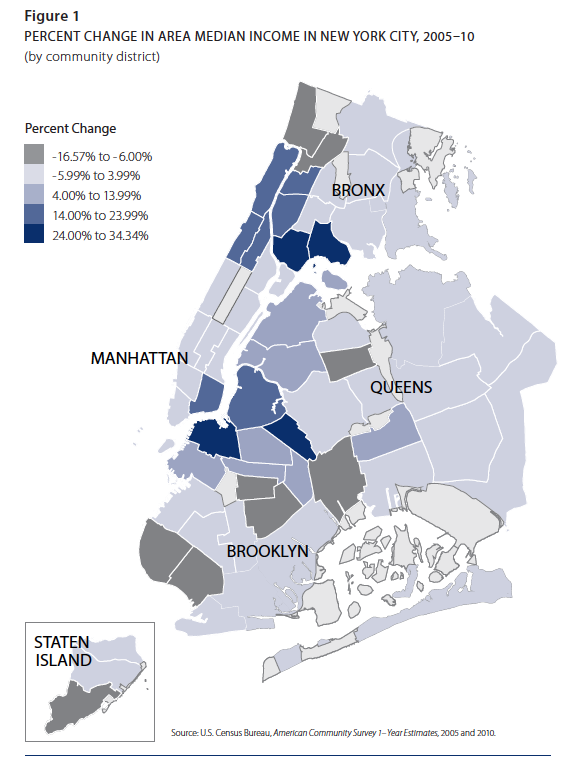
Poverty destabilization is not, however, an inevitable consequence of gentrification, nor is it even an inevitable consequence of gentrification in areas of high poverty. To be sure, the negative effects of gentrification are amplified most when the arrival of new residents creates a stark income inequality. The higher cost of living and sudden change in neighborhood affordability are the catalyst that disrupts low-income lifestyles and increases poverty and homelessness in surrounding areas, contributing to the conditions shown in Figure 2. That said, buffers do exist that are capable of mitigating this chain reaction. For example, affordable housing (whether through rent regulation or the existence of public units) can help keep residents in their homes and limit the amount of competition in local housing markets. Unfortunately, these buffers are becoming scarce in New York City, increasing the likelihood that the patterns seen previously in Brooklyn and that are now evident in Upper Manhattan and the Bronx will eventually spread further.
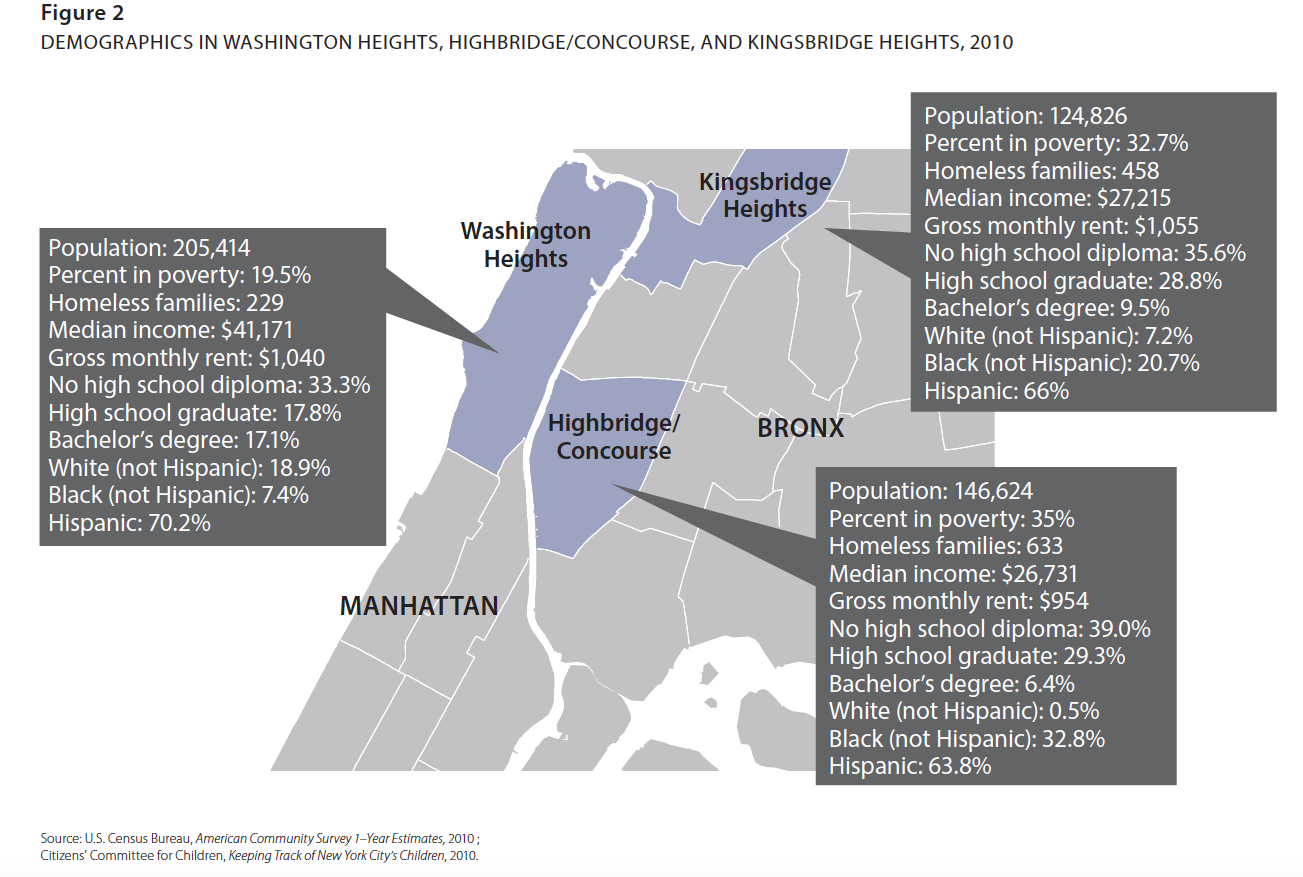
In the Bronx, the Dark Side of Gentrification
The neighborhoods of Upper Manhattan, such as Harlem and Washington Heights, have long been economically divorced from parts of the borough to the south.3 In 2005 the number of homeless families coming from the four districts north of Central Park was nearly three times the total for the rest of the borough combined. Because these neighborhoods are located farther from Wall Street and Midtown than are many areas of Brooklyn and Queens, it is perhaps unsurprising that they have been late to experience significant gentrification. They have done so in recent years, however, as the demographic shifts in education, income, and racial composition collectively understood as signs of gentrification have begun to take place. Unlike in Bed-Stuy and Brownsville, though, there is little evidence of an intra-borough imbalance being created. In Washington Heights, the northernmost district of Manhattan and so the most likely to experience the spillover effects of a general south-to-north gentrification, the median income increased 16.1% during 2005–10.
The uniformity with which the demographics of Upper Manhattan have reshaped themselves contrasts with the much more varied experiences seen in the southern parts of the Bronx. Given that areas such as Kingsbridge Heights, University Heights, and Highbridge/Concourse all share the same riverfront border with Washington Heights, one might expect a degree of similarity across measures of gentrification. However, the experiences of these community districts could not be more mixed. Of the areas bordering Manhattan, the community district encapsulating Bedford Park and Kingsbridge Heights appears to be the most destabilized by the gentrification occurring around it.
The divergences seen in the demographic trends of the neighborhoods surrounding the Harlem River contrast with the uniformly worsening nature of the crisis of family homelessness in the area. As seen in Figure 3, the number of families entering shelter from Washington Heights increased 26% from 2005 to 2010, from 181 families to 229. Highbridge/Concourse, the Bronx district with the highest number of homeless families, saw its total rise 37% over the same five years. Kingsbridge Heights, while having only the seventh-highest number of homeless families in the Bronx, had the most dramatic increase, with 94% more families requiring temporary housing than in 2005. By looking more closely at exactly what is happening in this district, we can sharpen our understanding not only of the negative impact of gentrification, but of the reasons underpinning the severity of this destabilization and its relationship with homelessness.
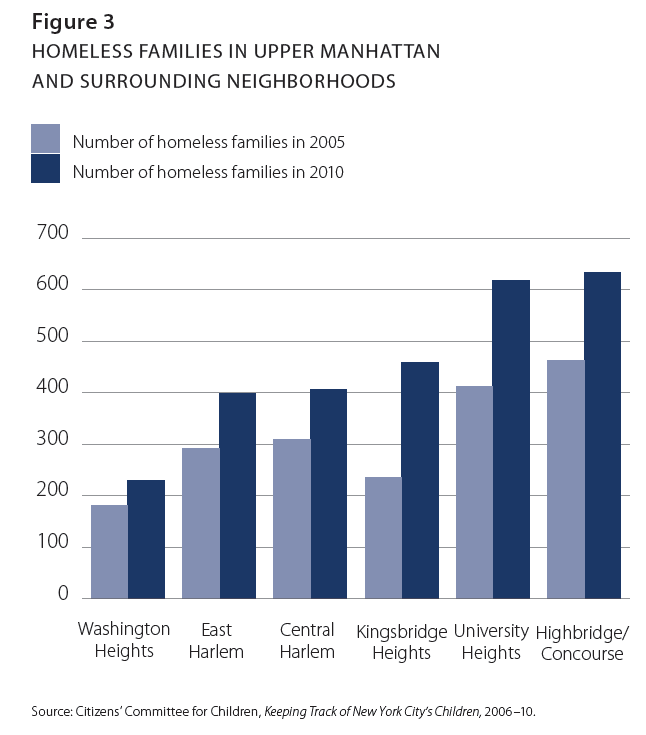
Measuring Gentrification: Race, Education, and Income
The great irony of gentrification is that, for all the time devoted to examining it in both academic and policy circles, it is not a neatly defined concept. Although the term has been used to describe many facets of neighborhood change, the most common indicators used to measure its prevalence in a given area are the racial composition, levels of educational attainment, and average income of the population, or rather the amount by which these demographics change over time. In Bed-Stuy and Brownsville, the most dramatic shift was a racial one; Bedford-Stuyvesant’s white population increased by 162% while Brownsville’s decreased by 26%. As seen in Table 1, comparing Washington Heights with areas of the South Bronx shows similar, albeit less dramatic, trends. During 2005–10 the number of white residents in both Washington Heights and Highbridge/Concourse increased, by 24% and 34%, respectively. By contrast, Kingsbridge Heights saw its white population decrease by 29%.
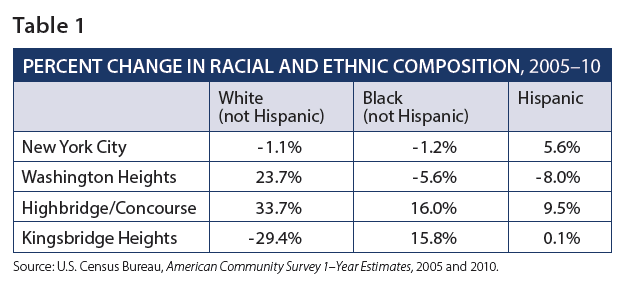
Tables 2 and 3 provide evidence of similar trends in how the population of these neighborhoods has changed with regard to education and income levels. Both Washington Heights and Highbridge/Concourse now have more residents with college degrees, with the size of these groups increasing by 10.8% and 37.5%, respectively. On average, the families in these neighborhoods are slightly better off financially than they were in 2005, with the median income in both neighborhoods rising more than 15%. Viewed separately, these changes might seem to be the result of nothing more than socioeconomic improvement for the existing residents, a kind of gentrification-in-place. When they are considered in conjunction, it is difficult to imagine these kinds of widespread changes taking place without massive migration from other parts of the city.
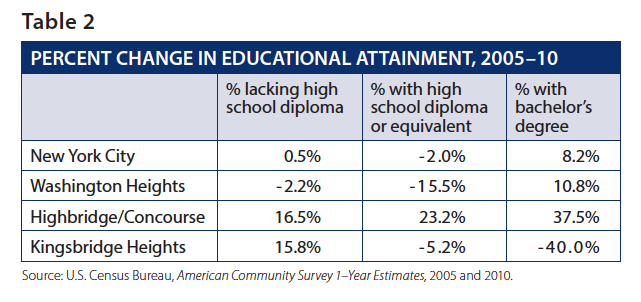
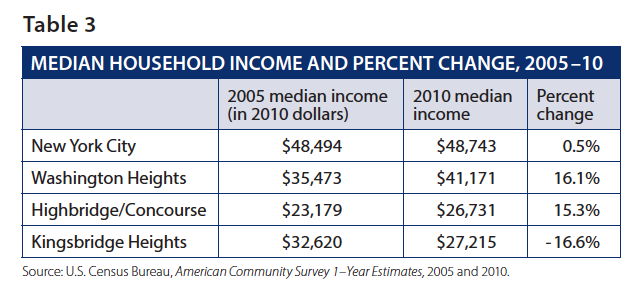
The side effect of neighborhood gentrification that is driven by migration rather than by localized improvement can be seen in Kingsbridge Heights. At the same time that new arrivals were changing the face of Washington Heights, Kingsbridge was being transformed by those being pushed out of Upper Manhattan. Median income fell 16.6%, and a greater proportion of the population lacked high school and college diplomas. In all likelihood, Kingsbridge Heights not only became the recipient of low-income families being priced out of nearby areas, but also witnessed its own pattern of emigration, as those with the ability to do so left the declining neighborhood.
Although the exact magnitude of migration within New York City (and the motivations behind such moves) is difficult to ascertain, survey research conducted by the U.S. Census Bureau offers evidence strongly suggestive of the interplay between the Bronx and Upper Manhattan. In 2011, 43.7% of households who had recently moved to the Bronx from Manhattan reported doing so for housing reasons, such as wanting lower rent or better apartments. Furthermore, 71.2% of households migrating to the Bronx from Manhattan after 2005 reported an income below $40,000 a year, whereas only 37.9% of recent arrivals in Washington Heights reported being below this income threshold. Migrants to Washington Heights were also most likely to have arrived from other parts of Manhattan, with 39.8% coming from elsewhere in the borough. In short, there is a rough but identifiable pattern, consistent with gentrification, underway: as new residents push northward into the upper reaches of Manhattan, low-income families must relocate to areas such as Kingsbridge Heights.4
From Gentrification to Destabilization
The demographic transformation of Washington Heights and Kingsbridge Heights reveals gentrification, but it is necessary to look at changes in the housing market to see how the lives of low-income residents have been destabilized. In both neighborhoods, the average rent for an apartment increased at a rate comparable to the rise seen in the city as a whole. If one presumes that the search for optimal housing is one of the primary drivers for migration in the first place, then this is to be expected. Wealthier migrants (or those with high income-growth potential) will be attracted to neighborhoods with lower costs of living, and those costs will rise in conjunction with demand as new arrivals populate the area. The same would be true of places like Kingsbridge Heights; even though the families arriving from Washington Heights are not necessarily wealthier, increased demand would nevertheless create upward pressure on rental prices.
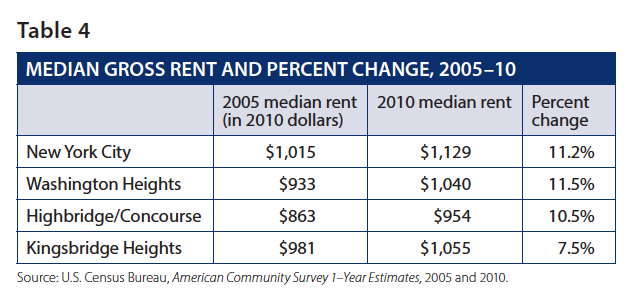
The reason that the market forces caused by gentrification result in sustained levels of poverty and homelessness is that the low-income residents being affected are unable to tolerate the increased costs. In 2005 Kingsbridge already had one of the highest rates of rent burden in the city. In other words, an affordability gap was already present, with the majority of residents forced to use over 30% of their income in order to maintain housing. The same is true of Washington Heights, where 52% of tenants were rent-burdened. Given the difficulty that residents were already having in maintaining their housing, the local housing market was primed for the kind of shake-up evidenced by the large demographic shifts.
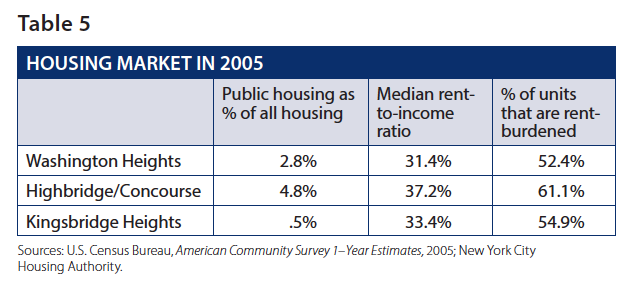
The local housing market can amplify the competition between low-income residents in gentrifying areas, but so too can it dampen it. The availability of public housing in an area not only guarantees that more longtime residents will be able to stay in their homes, but also decreases the number of people pushing into an adjacent neighborhood and pressuring the housing market there. In Washington Heights, only 2.8% of all housing units were public housing. Kingsbridge Heights has even fewer, with less than 1% of the district’s housing stock owned by the city. This dearth creates a twofold effect; just as a neighborhood is more vulnerable to heightened turnover when there is less public housing keeping families rooted in the area, so too are areas without this bulwark more likely to be the destination of those pushed out by gentrification, as they fill housing vacancies created by the emigration of others. By contrast, in Highbridge/Concourse, not only were a greater percentage of its existing low-income residents protected from market pressure; the greater share of the housing market taken up by public housing meant that there were fewer vacancies for displaced families to seek out.
To understand public housing’s stabilizing effect, however, we must know the current realities of how such housing is utilized. Public housing units typically have the lowest turnover of all rental housing; in 2011 the vacancy rate for public housing was only 1.4%, less than half of the citywide rate.5 The average length of stay in a New York City Housing Authority apartment is 20.7 years, and tenants have the ability to pass leases onto family members.6 The attractiveness of public housing as a long-term housing option is one reason why it is such a scarce resource; as of March 2013, there were 167,353 families on the waiting list for apartments. The theoretical benefit that public housing can provide to low-income families being pushed out by gentrification is diminished by these units’ being doubly unavailable: they are scarce in terms of both number and number of vacancies.
The Impact of Destabilization on Neighborhoods and Families
The destabilization of the housing market due to nearby gentrification could have lasting repercussions for both the affected neighborhoods and the low-income families who inhabit them. For the former, the danger is that the increased concentration of poverty will trap them in vicious cycles of low investment and opportunity. Between 2005 and 2009, both Kingsbridge Heights and Washington Heights ranked in the bottom 40% of districts by new-unit construction.7 The school district containing Kingsbridge Heights also consistently ranks among the highest in the city for over-enrollment; in 2010, the number of students was 100.9% of building capacity.8 Although there are myriad ways to measure neighborhood investment and quality, the presence of distressed schools and the slow rate at which new housing is being created are indicative of the type of conditions that are likely to be “locked in” by the re-concentration of poverty in the areas surrounding Upper Manhattan. This has implications for New York City, as these areas become permanent feeder communities into the shelter system.
The same threat, of current conditions becoming an unbreakable pattern, applies to the low-income families being destabilized as well. Recent sociological studies have illustrated how multigenerational cycles of poverty and homelessness can be created and perpetuated by factors such as low neighborhood quality or placement of children in the foster care system.9 In New York City, the difficulty of breaking such a cycle can be seen in the fact that over 50% of families who enter city shelters have experienced homelessness before. Episodes of homelessness also last longer than before, with the average family in shelter now staying over 13 months.10 In short, for poor families affected by the most recent wave of gentrification, the impact of becoming homeless is likely to be significant, in both the short and long term.
The consequences of poverty and homelessness for both neighborhoods and families may not be new, but their amplification due to rapid gentrification and destabilization is. In 2005 Washington Heights and Kingsbridge Heights had comparable levels of family homelessness, but the inability of either housing market to compensate for the economic pressures of gentrification in a way that would have protected low-income residents created stronger ripple effects in the latter. With gentrification unlikely to disappear as a significant economic and social force, it is imperative that the process be managed in a way that does not produce the kind of polarized results seen in Brooklyn and the Bronx. Developments over the last decade suggest that allowing unrestricted market forces to dictate housing may create an environment where the poor must choose between a painful scramble for affordability and a descent into homelessness.